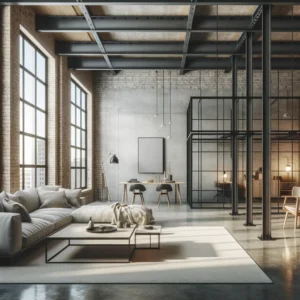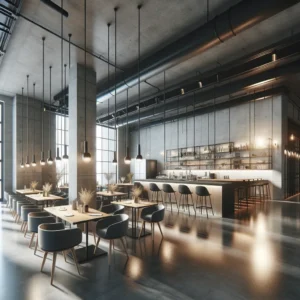Introduction
The minimalist industrial style, a fusion of the rawness of industrial design and the elegant simplicity of minimalism, is a growing trend in the world of interior design. Born from the adaptive reuse of industrial spaces for homes and offices, this style combines elements such as exposed concrete, steel beams and rustic wood with a neutral color palette and clean lines. The evolution of the industrial style, with its roots in the post-industrial era, into sophisticated minimalism reflects a shift from utilitarian workspaces to contemporary, functional living environments. Today, the minimalist industrial style is highly valued for its ability to create spacious, airy spaces that are both aesthetically appealing and highly functional. Its popularity is due to its versatility and the way it balances raw beauty with refined simplicity, making it a relevant and desirable choice in the modern design landscape.
Minimalist Industrial Style Concept
The minimalist industrial style is a unique aesthetic in the world of interior design, characterized by the harmonious synthesis between the robustness of industrial design and the elegant simplicity of minimalism. This style is marked by three key elements: the use of raw materials, the predominance of simple lines and a neutral color palette.
Raw Materials
At the heart of the minimalist industrial style are raw, unfinished materials. Elements such as exposed concrete, exposed brick, steel and untreated wood are often used to create a space that celebrates the intrinsic beauty and texture of these materials. These materials not only lend an authentic, raw character to the space, but also pay homage to the industrial history of the buildings that are often converted into residential or commercial spaces.
Simple Lines
Clean, simple lines are another key pillar of the minimalist industrial style. Unlike traditional industrial design, which can include more complex and ornate details, minimalism seeks clarity through simplicity. Furniture and decorations are chosen for their functional form and uncomplicated aesthetic, avoiding excess and keeping the focus on functionality and open space.
Neutral Color Palette
The color palette in a minimalist industrial space tends to be neutral, with shades such as gray, black, white, and variations of brown being the focus. This color choice helps create a calm and cohesive environment, allowing the materials and textures to speak for themselves without the distraction of vibrant colors or intricate patterns.
Influences and Examples
The minimalist industrial style is influenced by both the functional needs of minimalism and the raw aesthetics of industrial design. Visual examples include lofts with exposed brick walls, large windows that let in natural light, and the use of simple yet elegant furniture. These spaces often display a symbiosis of old and new, where historic industrial structures are revitalized with modern, minimalist design.
In short, the minimalist industrial style is a celebration of simplicity and functionality, where the charm of the industrial past meets the clarity and efficiency of contemporary design.
Functionality and Practicality
The minimalist industrial style, more than an aesthetic choice, is a manifesto of functionality and practicality in interior design. This approach maximizes the use of space through a series of clever strategies that combine the efficiency of minimalism with the robustness of industrial design.
Space Maximization
One of the main characteristics of the minimalist industrial style is its ability to create a sense of spaciousness and openness. This is achieved through the use of large windows that allow plenty of natural light to enter, and the high ceilings that are often found in converted industrial buildings. Furniture is strategically arranged to maximize circulation space, while the straight lines and simple design of the furniture help to avoid a sense of clutter.
Detachment and Functionality
At the heart of minimalism is the concept of decluttering – the idea that less is more. This translates into the careful selection of furniture and decorations, where each piece is chosen not only for its appearance but also for its function. By avoiding excess furniture and decoration, you create an environment that values free space, promoting a more peaceful and focused environment.
Storage and Organization Strategies
In a minimalist industrial space, storage and organization are designed to be both aesthetically pleasing and practical. Multi-functional furniture, such as sofas with built-in storage or coffee tables that double as storage units, are common. Storage solutions tend to be discreet and integrated, such as built-in shelves or cabinets that blend into the walls. These storage strategies help keep the space clutter-free, ensuring that each item has its designated place, while also contributing to the overall minimalist aesthetic of the space.
The minimalist industrial style, therefore, is not just a design trend, but a functional and practical approach to everyday life, promoting environments that are at once spacious, organized and aesthetically appealing.
Tips for Embodying the Minimalist Industrial Style
Incorporating minimalist industrial style into a space requires a thoughtful and considered approach to selecting furniture, décor, lighting, and materials. Here are some tips to help you create a space that reflects this unique aesthetic.
Furniture and Decoration Selection
When choosing furniture for a minimalist industrial space, opt for pieces that combine functionality with simple design. Furniture with clean lines and geometric shapes is ideal. Opt for sturdy pieces made from materials like steel, wood or concrete. When it comes to decorations, moderation is key. Choose a few items that have a strong visual impact or special meaning. Black and white artwork or metal sculptures can add character without overwhelming the space.
Use of Lighting
Lighting is crucial to a minimalist industrial style. It not only serves to illuminate the space, but also to create depth and dimension. Opt for industrial-style fixtures, such as metal pendants or track lights, and consider task lighting in work areas. Natural light should be maximized whenever possible, so keep windows clear and use light-colored curtains to soften the light.
Choice of Materials and Textures
The materials and textures you choose should reflect the raw, unfinished elements that characterize industrial style. Include concrete surfaces, exposed brick, reclaimed wood, and metal. To add a bit of warmth and softness, incorporate fabrics like linen or cotton in neutral tones. Area rugs in solid colors or with subtle patterns can also help define spaces within an open-plan space.
By adopting these tips, you can create a space that not only showcases the minimalist industrial aesthetic, but also offers functionality and comfort. Remember, the goal is to balance the rugged, rustic charm of industrial with the clarity and simplicity of minimalism, creating a space that is both welcoming and visually striking.
Benefits of Minimalist Industrial Style
The minimalist industrial style offers several benefits, both psychological and aesthetic, as well as being practical in terms of cleaning and maintenance, and highly adaptable to different types of spaces.
Psychologically, this style promotes a sense of calm and order. The combination of clean lines, neutral color palettes, and lack of clutter contributes to a less stressful and visually relaxing environment. The simplicity of the design helps reduce the feeling of chaos, providing a peaceful retreat from the hectic everyday life.
Aesthetically, the minimalist industrial style is appealing for its blend of raw textures and simplistic design, creating a visual balance that is both welcoming and modern. This style is known for its versatility and ability to complement a variety of spaces, from urban lofts to country homes.
Finally, ease of cleaning and maintenance is a significant advantage. Preferring durable, easy-to-clean surfaces like concrete and metal and minimizing unnecessary ornamentation makes the space easier to maintain. This practical approach makes the minimalist industrial style not only aesthetically pleasing, but also functional and convenient for everyday use.
Successful Examples of Minimalist Industrial Style
The minimalist industrial style has been successfully applied to a variety of spaces, from private homes to commercial establishments and modern offices. Here are some notable examples:
- Modern Loft Apartment: This image shows a modern loft apartment in an urban setting. It features exposed brick walls, steel beams and minimalist furniture, with a neutral color palette creating a relaxing and harmonious atmosphere.

- Stylish Coffee: This image illustrates a stylish cafe in an urban area, designed with a minimalist industrial style. The interior features polished concrete floors, pendant lighting and minimalist furniture, offering a modern and uncluttered atmosphere.

- Contemporary Office: Here we have a contemporary office space in a converted warehouse that embraces minimalist industrial design. The open layout includes raw materials like exposed brick and steel, combined with minimalist office furniture designed to foster a creative and efficient work environment.

These examples demonstrate the versatility and appeal of the minimalist industrial style. By cleverly reusing spaces and combining industrial and minimalist elements, it is possible to create environments that are not only visually striking, but also functional and comfortable for a variety of uses.
Conclusion
Minimalist industrial style is not just a design trend, but a functional and aesthetic approach that resonates deeply in the modern era. Combining the simplicity of minimalism with the robustness of industrial design, it offers an elegant solution for maximizing space and promoting mental clarity. This style is ideal for those seeking a contemporary living or working environment that is clean and uncluttered, yet still has character and personality. I encourage everyone to explore and adapt the minimalist industrial style to their own spaces, creating unique environments that reflect their personal preferences and functional needs. It is a versatile style that offers endless possibilities for customization and innovation in interior design.
